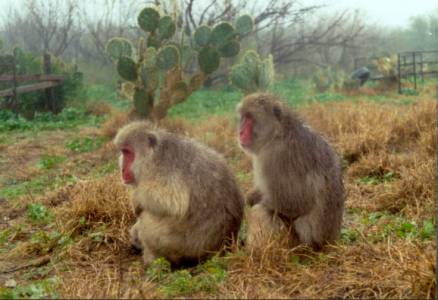How to Arrest a Texas Snow Monkey
The Texas Story Project.

In 1973, my parents, upon returning from their travels through Mexico and Guatemala for my grandfather's funeral, found that while they were gone, my aunt Helen, a UT student at the time, convinced my grandfather to accept a homeless troupe of Japanese macaque snow monkeys. The snow monkeys were originally from Arashiyama, outside Kyoto. She sold him on the idea that they were worth $1,000 USD—in 1970s money—as research animals, which to him, as a Texas rancher, seemed like a profitable proposal. As it turned out, this was not the case. Their DNA was not suitable for that type of research.
Interestingly, this homeless troupe was actually the product of another ill-thought entrepreneurial venture in Japan, as the monkeys were brought to Arashiyama to amuse the tourists who went there as a romantic destination. But they bred too rapidly to be kept under control.
Given that the Vietnam War was going on at the time, the monkeys were secretly flown in from Arashiyama by the Japanese Airforce to the Lackland Airforce Base in San Antonio, then transferred to the ranch to avoid protests from Japanese citizens. The snow monkeys had been enclosed in an electric fence to protect them from the coyotes and bobcats, but basically were expected to forage. The fence really did not keep them in. The monkeys figured out when the pulse of electricity charged the fence and would leave and come back into the enclosure at will.
Protocol was important for the researchers and visitors were instructed to not ‘stare’ at any monkey as this was considered a challenge and the monkey may charge at you, teeth glaring and ready to bite. My father heard the researchers’ moan that few offspring were added to the troop, a few ‘peripheral males’ had ‘escaped’ and saw the bare branches of the few trees remaining. He suggested perhaps the Purina monkey-chow diet should be augmented with a vegetable source of Vitamin A, like the scrap carrots that were dumped from near-by harvests. He helped to arrange for a dump truck to deliver the broken carrots, and soon their coats grew shiny and they did have more baby monkeys—which was ironic that this was desired considering that the monkeys had been relocated from Kyoto exactly because they reproduced too fast and had become a problem.
The "escaped peripheral males," while somewhat anticipated, were a source of several local news items. One rancher about 5 miles away found one such monkey making himself at home in his ranch house. Another monkey was sighted on a telephone pole near Dilley, Texas, and a deputy sheriff was sent to try to "capture" him. In true Texas style the deputy pointed his pistol at the monkey high on the pole and ordered him down. The monkey actually climbed down the pole, and when the deputy could reach him, he used handcuffs so the monkey was ‘trapped’ around the pole, tranquilized him, and somehow they got the monkey in the backseat of the patrol car still handcuffed. Dazed, confused, and handcuffed the young male macaque rode to the station, gazing out the window, and waited until one of the researchers came to get him. Eventually, all the monkeys were relocated as my other aunt, Gary, who inherited the ranch after my grandfather passed away, was not quite as supportive of the monkey’s antics.
Posted October 29, 2014
Join 26 others and favorite this
TAGGED WITH: Rural Experience, Unforgettable Characters